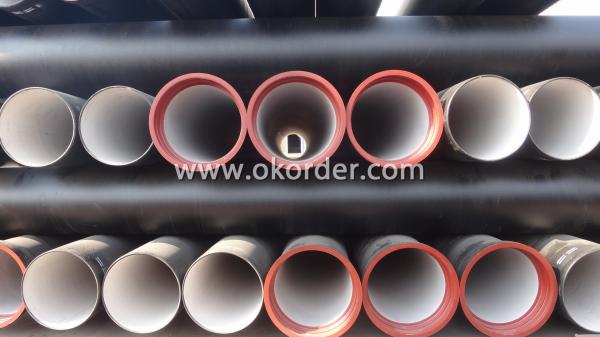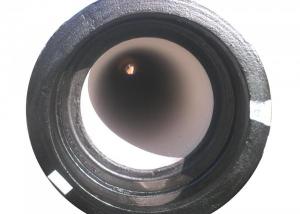Push-on Joint T Type Ductile Iron Pipe Class C
- Loading Port:
- China Main Port
- Payment Terms:
- TT or LC
- Min Order Qty:
- 1 Metric Ton m.t.
- Supply Capability:
- 300000 Metric Tons per Year m.t./month
OKorder Service Pledge
OKorder Financial Service
You Might Also Like
General introduction of Push-on Joint T Type Ductile Iron Pipe Class C
•Material: Ductile Cast Iron
•Size Range: DN 80mm to DN 2000mm
•Unit Effective Length: 5.7m or 6m or negotiable
•Manufacture Standard: ISO 2531:1998/ EN 545:2006/EN 598:2007
•Annual capacity: 300,000 tons
• Internal lining: cement mortar lining comply with ISO4179.
External coating: sprayed metallic Zinc coating (min.130g/m2) according to ISO8179 + bitumen painting (min.70μm) according to BS3416.
Gasket: Matched 100% natural rubber gasket in accordance with ISO4633.
•Special requirements on external coating and internal lining can be applied
•We also provide accessories such as SBR/EPDM rubber gaskets, lubricant paste, pipe caps, PE sleeves, etc.
Features of Ductile Iron Pipes:
Ductile cast iron, also called ductile iron, spheroidal graphite iron, or nodular cast iron, is a type of cast iron invented in 1943. While most varieties of cast iron are brittle, ductile cast iron is much more flexible and elastic, due to its nodular graphite inclusions.
· Ductile Iron Pipe offers proven reliability and the quality.
· It is quick and easy installation.
· The ductile iron pipe has high pressure capability.
· Available in sizes DN80 – DN2000
· Both T Type (Push-on Joint) and K Type (Mechanical Joint) are available
· Match 100% Natural rubber / SBR / EPDM rubber gaskets
Application:
Much of the production of ductile iron is in the form of ductile cast iron pipe, used for water supply and sewerage design. Ductile iron pipe is stronger and easier to tap, requires less support and provides greater flow area compared with pipes made from other materials like PVC, concrete, polyethylene or steel.
Specification of Push-on Joint T Type Ductile Iron Pipe Class C:
Standard wall thickness of Push-on Joint T Type Ductile Iron Pipe Class C
Nominal wall thickness of pipes: e=K (0.5+0.001*DN)
Where, DN: Nominal diameter; K: Coefficient (K=7, 8, 9, 10, 11, 12)
Nominal wall thickness of pipe fittings: e=7+0.014*DN (K=14) e=6+0.012*DN (K=12)
|
Nominal Diameter |
Wall Thickness(mm) | ||||||
|
DN(mm) |
Pipe |
Fittings | |||||
|
Class C |
K8 |
K9 |
K10 |
K12 |
K12 |
K14 | |
|
80 |
4.4 |
6 |
6.0 |
7 |
8.1 | ||
|
100 |
4.4 |
6.0 |
7.2 |
8.4 | |||
|
125 |
4.5 |
6.3 |
7.5 |
8.8 | |||
|
150 |
4.5 |
6.3 |
7.8 |
9.1 | |||
|
200 |
4.7 |
6.3 |
8.4 |
9.8 | |||
|
250 |
5.5 |
6.8 |
7.5 |
9 |
9 |
10.5 | |
|
300 |
6.2 |
6.4 |
7.2 |
8 |
9.6 |
9.6 |
11.2 |
|
350 |
6.3 |
6.8 |
7.7 |
8.5 |
10.2 |
10.2 |
11.9 |
|
400 |
6.5 |
7.2 |
8.1 |
9 |
10.8 |
10.8 |
12.6 |
|
450 |
6.9 |
7.6 |
8.6 |
9.5 |
11.4 |
11.4 |
13.3 |
|
500 |
7.5 |
8 |
9 |
10 |
12 |
12 |
14 |
|
600 |
8.7 |
8.8 |
9.9 |
11 |
13.2 |
13.2 |
15.4 |
|
700 |
8.6 |
9.6 |
10.8 |
12 |
14.4 |
14.4 |
16.8 |
|
800 |
9.6 |
10.4 |
11.7 |
13 |
15.6 |
15.6 |
18.2 |
|
900 |
11.6 |
11.2 |
12.6 |
14 |
16.8 |
16.8 |
19.6 |
|
1000 |
12.6 |
12 |
13.5 |
15 |
18 |
18 |
21 |
|
1200 |
13.6 |
13.6 |
15.3 |
17 |
20.4 |
20.4 |
22.8 |
|
1400 |
15.7 |
15.2 |
17.1 |
19 |
22.8 |
22.8 |
26.6 |
|
1500 |
16.7 |
16 |
18 |
20 |
24 |
24 |
31 |
|
1600 |
17.7 |
16.8 |
18.9 |
21 |
25.2 |
25.2 |
29.4 |
|
1800 |
19.7 |
18.4 |
20.7 |
23 |
27.6 |
27.6 |
32.2 |
|
2000 |
21.8 |
20 |
22.5 |
25 |
30 |
30 |
35 |
Push on Joint T type Ductile Iron Pipe Class C(ISO2531:2009)
Dimensions of preferred class
|
DN(mm) |
DE(mm) |
Wall thickness (mm) |
Approximate Weight of Socket (kg) |
Weight of Straight Section(kg/m) |
Weight of Each Unit(kg/6m) |
Class |
|
Nominal Diameter |
Outside Diameter | |||||
|
80 |
98 |
4.4 |
3.4 |
9.1 |
59 |
C40 |
|
100 |
118 |
4.4 |
4.3 |
11.1 |
71 |
C40 |
|
125 |
144 |
4.5 |
5.7 |
14.1 |
90 |
C40 |
|
150 |
170 |
4.5 |
7.1 |
2.5 |
106 |
C40 |
|
200 |
222 |
4.7 |
10.3 |
22.6 |
145 |
C40 |
|
250 |
274 |
5.5 |
14.2 |
32.6 |
211 |
C40 |
|
300 |
326 |
6.2 |
18.6 |
43.9 |
282 |
C40 |
|
350 |
378 |
6.3 |
23.7 |
51.9 |
335 |
C30 |
|
400 |
429 |
6.5 |
29.3 |
60.8 |
395 |
C30 |
|
450 |
480 |
6.9 |
38.3 |
72.3 |
476 |
C30 |
|
500 |
532 |
7.5 |
42.8 |
87.0 |
566 |
C30 |
|
600 |
635 |
8.7 |
59.3 |
120.6 |
784 |
C30 |
|
700 |
738 |
8.6 |
79.1 |
142.0 |
932 |
C25 |
|
800 |
842 |
9.6 |
102.6 |
176.9 |
1165 |
C25 |
|
900 |
945 |
10.6 |
129.0 |
215.5 |
1422 |
C25 |
|
1000 |
1048 |
11.6 |
161.3 |
262.1 |
1759 |
C25 |
|
1100 |
1152 |
12.6 |
194.7 |
313.55 |
2103 |
C25 |
Photo show of Push on Joint T type Ductile Iron Pipe Class C


- Q:Ductile iron pipe, socket connection, pipe length, you can cut open it?
- Yes, but the pipe that needs cutting is a cut off pipe with a scissors mark.
- Q:What is the difference between spheroidal graphite cast iron QT400-15 and QT400-15A? What does the A mean later?
- The front is the material grade, and the back of the A should have special requirements.
- Q:How to control mortar proportioning in ductile iron pipe cement coating
- The mix ratio of cement coated mortar for ductile iron pipes refers to the weight ratio of various raw materials consisting of ductile iron pipes and cement coated mortars.
- Q:Can ductile iron pipes be used for underground slurry pipelines?
- Yes, ductile iron pipes can be used for underground slurry pipelines. Ductile iron pipes are known for their strength, durability, and resistance to corrosion, making them suitable for a variety of applications including underground slurry pipelines. They provide a reliable and cost-effective solution for transporting slurry, which is a mixture of solids and liquids, over long distances. The inherent toughness and flexibility of ductile iron pipes allow them to withstand the abrasive nature of slurry and the external loads associated with underground installation. Additionally, ductile iron pipes can be easily joined using various methods, ensuring a secure and leak-free pipeline system. However, it is important to consider the specific properties of the slurry being transported and consult with experts to determine the appropriate pipe specifications and design considerations for the underground slurry pipeline.
- Q:Are ductile iron pipes resistant to UV radiation?
- No, ductile iron pipes are not resistant to UV radiation.
- Q:Are ductile iron pipes resistant to biogenic sulfide corrosion?
- Yes, ductile iron pipes are resistant to biogenic sulfide corrosion. The high strength and durability of ductile iron make it highly resistant to the corrosive effects of biogenic sulfide, making it an ideal choice for underground sewer and wastewater applications.
- Q:What is the maximum operating pressure for ductile iron pipes?
- The maximum operating pressure for ductile iron pipes can vary depending on factors such as pipe diameter, wall thickness, and the specific application. However, in general, ductile iron pipes are designed to withstand pressures up to 350 psi (pounds per square inch) or even higher in some cases. It is important to note that local regulations, engineering standards, and manufacturer specifications should be consulted to determine the maximum operating pressure specific to a particular ductile iron pipe system.
- Q:What is the expected pressure rating for ductile iron pipes?
- The expected pressure rating for ductile iron pipes can vary depending on various factors such as the pipe diameter, wall thickness, and the specific application it is being used for. However, generally speaking, ductile iron pipes are designed and manufactured to withstand high-pressure conditions. They are commonly used in water and wastewater systems, where they can typically handle pressures ranging from 150 psi (pounds per square inch) up to 350 psi or even higher. It is important to consult the manufacturer's specifications or relevant industry standards for specific pressure ratings based on the pipe's size and application to ensure safe and reliable operation.
- Q:What's the difference between cast iron pipe and steel pipe?
- Steel tube (Steel pipe) production technology development began in the bicycle manufacturing industry, the rise of the early nineteenth Century during the oil development, the two world war ships, boilers, aircraft manufacturing, manufacturing of power boiler after the Second World War, the development of chemical industry of petroleum and natural gas drilling and transportation, will effectively promote the the yield and quality of varieties, the development of steel tube industry.
- Q:What is the difference between a cast iron pipe and a ductile iron pipe?
- The ball compressive strength of ductile iron pipe is much higher than that of cast iron pipes, buried in the ground, the car is not easy to be crushed.
1. Manufacturer Overview |
|
|---|---|
| Location | Henan, China |
| Year Established | 1958 |
| Annual Output Value | Below US$1 Million |
| Main Markets | Mid East, Africa, South Asia, Eastern Asia |
| Company Certifications | ISO 9001:2008;ISO2531:2000 |
2. Manufacturer Certificates |
|
|---|---|
| a) Certification Name | |
| Range | |
| Reference | |
| Validity Period | |
3. Manufacturer Capability |
|
|---|---|
| a)Trade Capacity | |
| Nearest Port | Tianjin; Qingdao |
| Export Percentage | 1% - 10% |
| No.of Employees in Trade Department | 3000 People |
| Language Spoken: | English; Chinese; Spain; Alabic |
| b)Factory Information | |
| Factory Size: | Above 150,000 square meters |
| No. of Production Lines | Above 6 |
| Contract Manufacturing | OEM Service Offered; Design Service Offered |
| Product Price Range | Average |
Send your message to us
Push-on Joint T Type Ductile Iron Pipe Class C
- Loading Port:
- China Main Port
- Payment Terms:
- TT or LC
- Min Order Qty:
- 1 Metric Ton m.t.
- Supply Capability:
- 300000 Metric Tons per Year m.t./month
OKorder Service Pledge
OKorder Financial Service
Similar products
New products
Hot products
Hot Searches
Related keywords



























